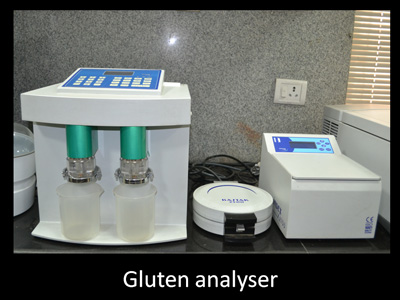Submitted by admin on
Chemical Laboratory
The lab has been fully facilitated to analysis / determine the chemical constituents and nutritive value of the food grains such as Carbohydrates, proteins, lipids, crude fibre, vitamins, minerals, ash, moisture etc. The lab is also used for research purpose by conducting various R&D activities on applied aspects of biochemical constituents present in foodgrains.
Some important major chemical quality parameters of foodgrains are;
1. Total Ash
2. Acid insoluble ash
3. Gluten
4. Free fat acidity
5. Alcoholic acidity
6. Total sugars (Carbohydrates)
7. Total fat (Lipids)
8. Crude protein
9. Minerals
10. Vitamins
11. Enzymes
Chemical changes
The various chemical changes that occur during storage are due to increased activity of endogenous and exogenous enzyme responsible for quantitative and qualitative changes in carbohydrates, proteins and fats of the cereals in addition to colour, flavour, taste and texture.
The parameters which are being analysed in the laboratory are:
1.Wheat Proteins and Gluten
The glutenin and gliadinare important proteins and are insoluble in water as they are essentially those which together with water to form the well-known cohesive and elastic like substance called gluten.

2.Determination of free fat Acidity (F, F,A,) Definition
Fat Acidity is defined as the number of mg of KOH required to neutralize the fatty acids from 100 gm of grain, calculated on moisture free basic.
3.Determination of Ash content
Total ash of food stuff is the inorganic residue remaining after the organic matter has been burnt away. The ash figure can be recorded as a general measure of quality. The percentage of mineral matter present in a flour usually given a useful indication of the grade of the flour.
4. Proteins
Protein is measured by the “classic Kjeidahl” nitrogen analysis, which assumes a constant relationship between total nitrogen and the complex of amino acids which lies together to form protein. In wheat flour this relationship is expressed by multiplying the nitrogen content by 5.7


5. Alcoholic Acidity
Enzymatic hydrolysis of Protein & phytin known as alcoholic acidity
6.Falling Number
High amylase activity means sprout damaged wheat, bread crumbles likely to be sticky and low amylase activity of sound wheat bread crumb is likely to be dry & loaf volume reduced.

7.Moisture content
The loss in mass caused as a result of heating for two hours at 130 to 133°C under specified conditions and expressed as percentage.














